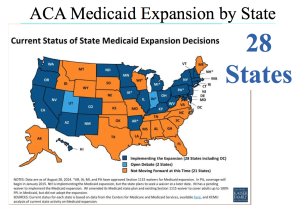
Health care continues improving for many Arizonans who took advantage of insurance offered by the Patient Protection and Affordable Care Act.
The uninsured rates in Arizona dropped by 4 percentage points, state hospitals uncompensated care costs decreased and the state added health care-related jobs.
Arizona’s uninsured rates dropped down from 20.14 percent before the act to 16.38 percent after the first open enrollment period, which was from Oct. 1, 2013 through March 31 according to Health Insurance. The second chance Arizonans has to sign up for insurance starts Nov. 15 and lasts until Feb. 15, 2015.
The number of uninsured in the United States have fallen by about 25 percent, or about 11 million people, according to an article by the New York Times.
The ACA aims to provide more Americans with affordable health insurance and to reduce the growth of uncompensated costs for hospitals. Critics, who dubbed the act Obamacare, continue challenging its provisions in court. Many newly minted U.S. senators and representatives vow to appeal the act.
Part of the act is two major provisions to help insure the uninsured. The first is to expand Medicaid program to the nation’s poorest in order to cover uninsured Americans, said Daniel Derksen, director of the Center for Rural Health at the University of Arizona. Second, he said, is to create a health insurance marketplace.
A total of 28 states have implemented the expansion of Medicaid. Medicaid was previously restricted to specific categories of low-income individuals.

States were given the option to have their own state-run marketplace or be part of the federal market. Arizona Gov. Jan Brewer chose not to form a state-run health care exchange and opted the state into the federal exchange, where an online marketplace is used to buy subsidized health care coverage.
Derksen believes a state-run exchange would increase coverage while giving the state flexibility in designing its own programs.
“Some states that did their own [market] did much better as far as helping eligible people,” Derksen said. “It also made it a very simple process and had a better participation rate of eligible people who have enrolled.”
In Arizona there are 6.5 million people, with only 1.2 million of that population uninsured before the act. Of that 1.2 million people who were uninsured, about 330,000 have acquired their coverage through the expansion of Medicaid. Of the 330,000 people that got coverage, 300,000 were just restoring their Medicaid.
“From the perspective of those people who would be eligible for Medicaid coverage who went ahead and signed up we’ve done very well,” Derksen said.
Since the first open enrollment, Arizona has added another 120,000 people who selected a qualified health insurance plan through Arizona’s federally facilitated marketplace, and about 85 percent are paying their premiums.
“But we could’ve had twice that if the process had been smoother and if people knew what their choices are,” Derksen said.
With the new act, parents can have their children under their plan until the age of 26, and 70,000 Arizonans are covered through their parents.
In Arizona alone, Hispanics and Latinos make up 700,000 of the uninsured population. Seventy percent of the United States uninsured Hispanics live in 10 states that are geographically in the lower third of the U.S, according to Derksen.
“The populations that we haven’t done well with are Latinos and Hispanics,” Derksen said. “They have low participation plan because most of them don’t realize they are eligible.”
“There are many factors that contribute to a low participation rate,” Derksen said. “Having a handout in Spanish doesn’t solve the language barrier – as many of the words don’t translate easily from English to other languages such as “co-pay,” “deductible,” “cost sharing” and “out of pocket expenses.”
Yet the majority of Hispanics who got insurance through the ACA acquired it through the expansion. The ACA makes it mandatory for people to buy insurance and although the act offers advanced premium, the “thought of having to pay for insurance, is a difficult concept for Hispanics to take because they now have to pay something,” said David Parra, director of Community Outreach of American Association of Retired Persons of Arizona.
“The difficulty of understanding the act with its technical terms has contributed to many people being confused and discouraged about even the possibility of getting insured,” Parra said.
Beginning of this year, part of the ACA, anybody without coverage for three consecutive months will make an individual shared responsibility payment with their tax returns filed in 2015, Parra said.
The IRS decided that the penalty will be either one percent of the household income or a flat dollar amount, which is $95 dollars per adult and $47.50 per child, whichever is greater.
In some instances the penalty can be waived in accordance with the IRS exemptions.
“A coalition of many agencies in Arizona are focusing on education,” Parra said.
Parra has also been part of 10 different conferences throughout the state to reach out to the Hispanic community statewide to educate them on their eligibility.
“The effort to educate Hispanic on ACA in Arizona is a very robust effort,” Parra said.
Yara Askar is a reporter for Arizona Sonora News, a service from the School of Journalism at the University of Arizona. Reach her at yaskar@email.arizona.edu

